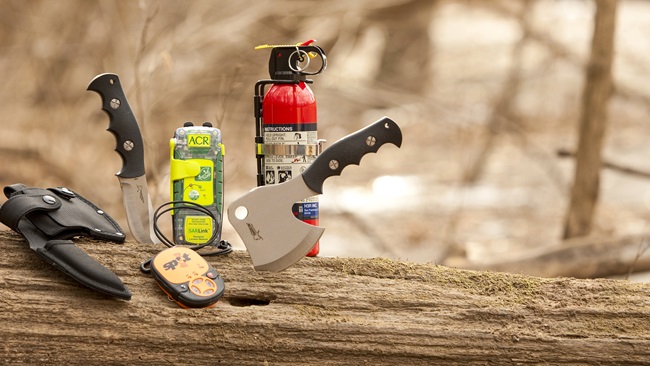Photography by Chris Rose
Turning final for a water landing on a placid lake, the de Havilland DHC–2 Beaver seems perfectly matched to its purpose.
Flaps set to 35 degrees, all six wheels tucked safely inside amphibious floats, airspeed at 75 miles per hour, and descending 400 feet per minute into a 10-knot headwind that ripples the blue water surface of Central Florida’s Crescent Lake.
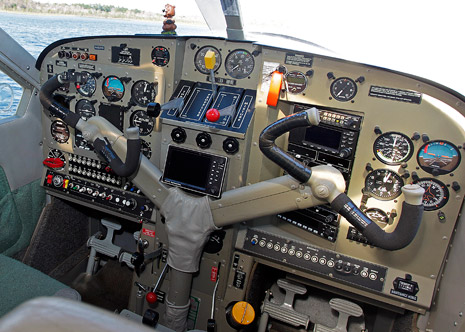
“This airplane looks like a truck, but it handles like a sports car,” says Tripp Wacker, an FAA designated pilot examiner and owner of Ryan Seaplanes, which trains new seaplane pilots, as well as those seeking advanced ratings, in this beautifully restored 1953 airplane.
The 450-horsepower Pratt & Whitney R-985 rumbles at a subdued 20 inches
of manifold pressure as our shadow passes over the tall pines lining the lakeshore, and Wacker keeps tossing out analogies describing the Beaver’s attributes. “It’s a Harley with wings,” he says. “It’s built like a tank, but has the control harmony of a [de Havilland] Chipmunk.”
An automated voice, as well as four blue lights on the gear warning system, confirms the wheels are up. Wacker repeats his pretouchdown mantra to make absolutely certain: “Four blue, no red, the gear is up for a water landing.”
The view ahead is sublime as the textured lake surface comes into sharp relief, and the airplane settles in a wind-protected area near a small island. The Wipline 6100 floats touch down softly, first the right one skimming the lake’s surface, followed by the left. A steady deceleration follows, and a plastic bobble-head Beaver on the glare- shield nods stupidly as the aircraft rocks fore and aft. In moments, the floats and not the wings are supporting the airplane’s full two-ton weight.
This touchdown is my first landing in a Beaver, and I’m anxious for more.
Power up to 36 inches manifold pressure; full back yoke; feel the airplane pitch up once, twice; now release the back pressure as the airplane accelerates on the step, then let it fly off the water. At 500 feet, raise the flaps, but not all the way. A 7-degree flap setting makes the airplane fly in a level attitude at cruise and improves engine cooling. Power back to 29 inches of manifold pressure, and reduce the propeller rpm to 1,900 for cruise.
“If you’re looking to carry heavy loads, out of short or rough places, for short distances, at low altitudes, this airplane will never disappoint you,” Wacker says. “If you want to go fast, fly high, or cover long distances, then you’d have to put a turbine engine on it. That helps the performance, but I’d never do it. This airplane is just perfect for the radial it’s got. Putting a turbine on it would be like seeing Wyatt Earp carrying a Taser. It’s just wrong.”
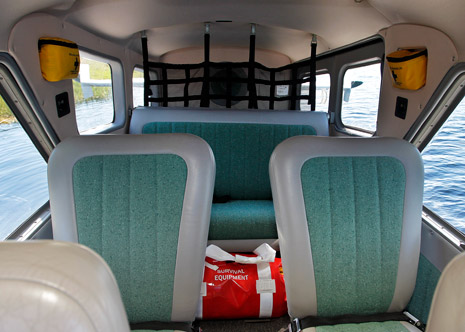
Aerial dog sled. The Beaver is the iconic bush airplane of Canada and the far north. It’s memorialized on a commemorative Canadian quarter. More than 1,650 DHC-2s were produced from 1947 until manufacturing stopped in 1967, and the U.S. military was one of the first and largest customers. The rugged airplanes remain mainstays among bush pilots in Alaska and Canada.
But a series of strange and shadowy events conspired to bring this one, serial number 526, all the way to sunny Florida. The airplane was sent from the Canadian factory where it was built in 1953 to Pakistan, where it stayed for more than 30 years spraying insecticide on mosquitoes. Then it went to Bangladesh and supposedly belonged to a flying club, but records are spotty. An aircraft broker in Alaska tracked the airplane down and purchased it, along with two other DHC-2s in various states of disrepair, in the mid-1990s and had them sent back to Canada for restoration.
This one, N450RA, underwent a long series of modifications that include Wipline amphibious floats, a Barron STOL kit, extended baggage, a fishing rod holder, new avionics—in all, a total of 81 STCs and Form 337 field approvals. It has won major restoration prizes at airshows including the Sun ’n Fun Fly-In.
Wacker bought it in 2005 and planned to use it as a promotional tool for an outdoor firm that caters to hunters and fishermen. When that didn’t pan out, he decided to test the flight-training market because he’d become attached to the airplane and wanted to find a way to keep it. “It’s such a great airplane that I really didn’t want to let it go,” he said.
Wacker specializes in seaplane instruction, and he also uses an Aviat Husky on amphibious floats for that purpose (see “Water Dog,” February 2012 AOPA Pilot). The Husky is a workhorse, but Wacker has been pleasantly surprised by demand for the Beaver.
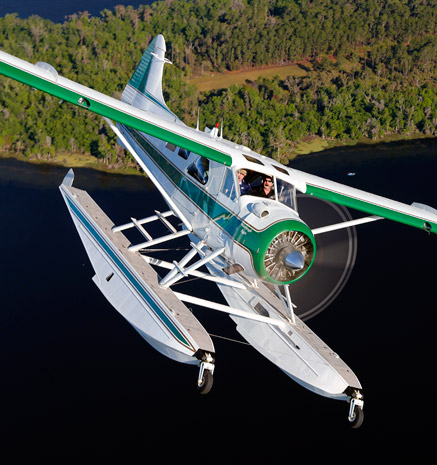 Some students are prospective Beaver owners who want aircraft checkouts. Others are seeking initial seaplane ratings and are willing to pay a premium to fly the big, complex airplane. A few are seeking advanced ratings such as a seaplane ATP and need a complex, instrument-equipped airplane in which to do it. And some are aficionados who simply want to fly for an hour or so in what is widely regarded as the classiest airplane in its category. A two-day checkout that consists of five flying hours and four hours of ground school sells for $2,950.
Some students are prospective Beaver owners who want aircraft checkouts. Others are seeking initial seaplane ratings and are willing to pay a premium to fly the big, complex airplane. A few are seeking advanced ratings such as a seaplane ATP and need a complex, instrument-equipped airplane in which to do it. And some are aficionados who simply want to fly for an hour or so in what is widely regarded as the classiest airplane in its category. A two-day checkout that consists of five flying hours and four hours of ground school sells for $2,950.
“Getting some stick time in a float Beaver is a bucket-list item for some people,” Wacker said. “And I understand why. It’s a rare and totally unique aviation experience.”
The amphibious floats are the most complex portion of the checkout, and Ryan Seaplanes has created animated computer graphics to show how the landing-gear hydraulic system—with its three pumps, two electric motors, circuit breakers, and gear advisory—all work. A wall-mounted screen in one of the classrooms allows students to review normal operations and multiple failure scenarios.
Ryan Seaplanes also provides a detailed manual, performance charts, and everything else needed to prepare for checkrides.
In the air. The most unusual aspect of flying the airplane for the first time is its hulking size. On amphibious floats, the wing is high off the ground, and climbing into the cockpit involves lots of actual climbing. And once you get there, the doors are surprisingly slim.
Inside the cockpit, one of the first things you notice is that the engine controls are mounted atop the panel, and the throttle, prop, and mixture knobs are of gigantic proportions. The oil filler cap is inside the cockpit so that crewmembers can add oil from inside, or even in flight—and having oil access inside the airplane is a bonus that those operating in the Arctic surely must appreciate.
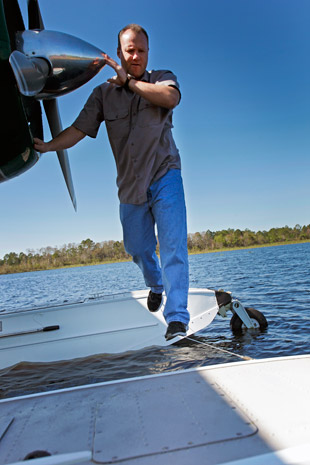
Checklists can be found on a rolling parchment mounted on the windshield between the two pilots. Engine start is standard for the carbureted R-985, and even in Florida, it takes a few minutes to warm the engine’s six gallons of oil. Taxiing requires differential braking, and the sight picture from the high perch takes some adjustment.
There are five fuel tanks (three in the belly and one in each wing), containing a total of 138 gallons, and the engine burns about 25 gallons an hour at cruise. The only “gotchas” in flying the Beaver have to do with flaps.
“De Havilland designed a great wing for this airplane,” Wacker said. “But it will not take off, climb, or land without the flaps in the proper position.”
Normal takeoffs are made with 35 degrees of flaps. Full flap deflection (50 degrees) is reserved for rough-water landings and emergencies.
We make a series of normal water takeoffs and landings at Crescent Lake, and join a Bonanza V35 for the photography portion of the flight over the nearby Atlantic.
The Beaver is an absolute delight, and I’m completely surprised by its light, crisp, and exquisite handling qualities as well as the sheer joy it inspires. Our photo flight with theBonanza photo airplane (expertly flown by Bruce Moore) lasts nearly two hours, but the time goes by so quickly that it feels much shorter.
Wacker says touching down on the wheels “is like landing a shopping cart,” and he cautions against holding the bow wheels off the ground too long.
“You want to lower them softly,” he says. “Don’t bang them on.”
One flight in the Beaver shows why pilots such as Harrison Ford, John Nordstrom, and Bill Anders choose to own and fly this model. It’s robust, obedient, and eager, and it does what it does with an easy grace and a style all its own.
It’s not fast, but it doesn’t have to be.
As one of the airplane’s designers said, to thrive in the arctic, the Beaver only had to be “faster than a dog sled.”
Email [email protected].
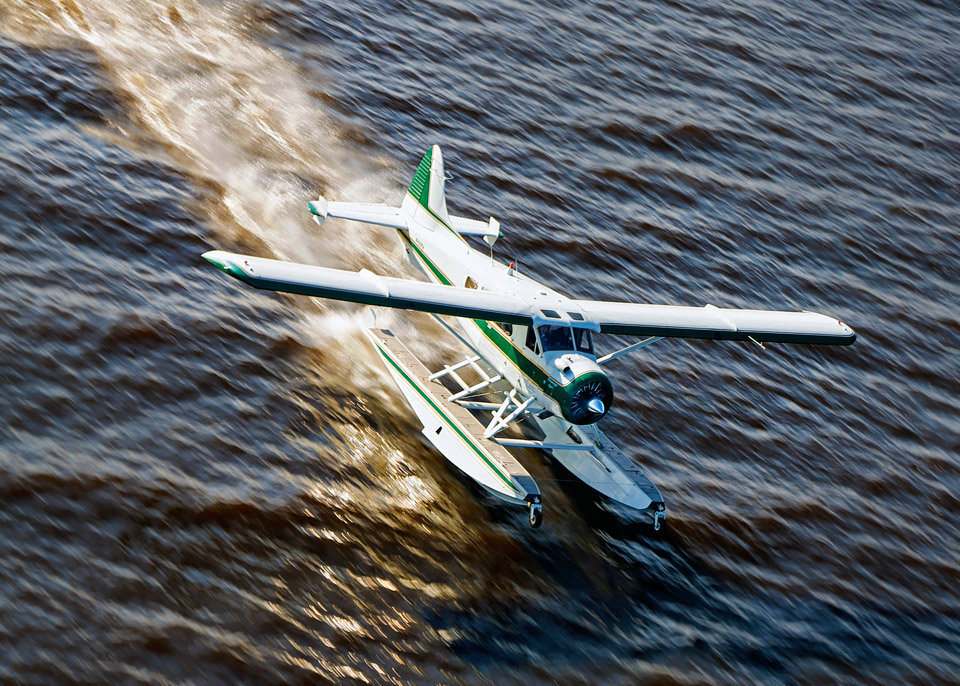
SPEC SHEET
DHC-2 Floatplane
$650,000 as tested
SPECIFICATIONS
Powerplant | Pratt & Whitney R-985 Wasp Jr. 450 hp
Length | 32 ft 9 in
Height | 10 ft 5 in
Wingspan | 48 ft 0 in
Wing area | 250 sq ft
Wing loading | 22.4 lb/sq ft
Power loading | 11.3 lb/hp
Seats | 8
Empty weight | 3,450 lb
Max gross weight | 5,600 lb
Useful load | 2,150 lb
Payload w/full fuel | 1,322 lb
Max takeoff weight | 5,600 lb
Fuel capacity | 138 gal (138 gal usable)
Oil capacity | 6 gal
PERFORMANCE
Takeoff distance over 50-ft obstacle | 1,610 ft
Rate of climb, sea level | 920 fpm
Max level speed, sea level | 155 mph
Service ceiling | 18,000 ft
Landing distance over 50-ft obstacle | 1,510 ft
LIMITING AND RECOMMENDED AIRSPEEDS
VX (best angle of climb) | 80 mph
VY (best rate of climb) | 95 mph
VA (design maneuvering) | 125 mph
VFE (max flap extended) | 105 mph
VS1 (stall, clean) | 60 mph
VSO (stall, flaps extended) | 45 mph
All specifications are based on manufacturer’s calculations. All performance figures are based on standard day, standard atmosphere, sea level, gross weight conditions unless otherwise noted.
EXTRA
The oil level for the Pratt & Whitney R-985 is measured in gallons, not quarts. Look for 6 gallons on the dipstick during preflight. And if you need to add oil in flight, it’s allowed.



